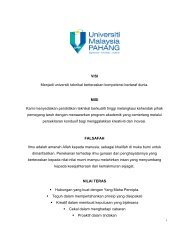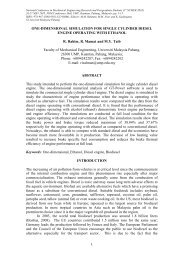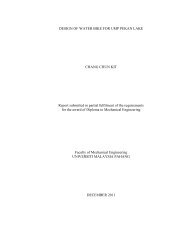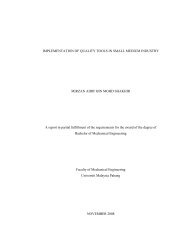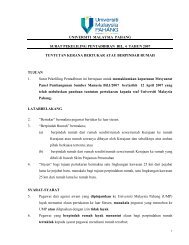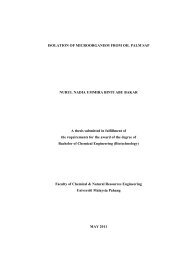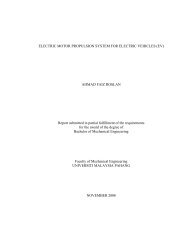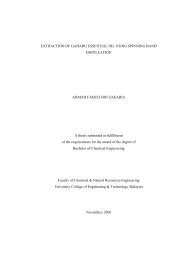EFFECT OF NOZZLE ANGLE ON JET IMPINGEMENT COOLING ...
EFFECT OF NOZZLE ANGLE ON JET IMPINGEMENT COOLING ...
EFFECT OF NOZZLE ANGLE ON JET IMPINGEMENT COOLING ...
You also want an ePaper? Increase the reach of your titles
YUMPU automatically turns print PDFs into web optimized ePapers that Google loves.
CHAPTER 1INTRODUCTI<strong>ON</strong>1.1 BACKGROUND <strong>OF</strong> STUDYAir jets have been widely used in many industrial applications in order toachieve enhanced coefficients for convective heating, cooling or drying. A single air jetor arrays of air jet, impinging normally on a surface are an effective method to enhanceheat and mass transfer. High convective heat transfer coefficient is a very importantfactor that leads to the many usage of impingement jets in industrial for heating andcooling purposes. Jet impingement is an attractive cooling mechanism due to thecapability of achieving large heat transfer rates. This cooling method has been used inindustrial applications such as annealing of metals, tempering of glass, cooling of gasturbine blades, cooling in grinding processes and cooling of photovoltaic cells. Jetimpingement has also used for high-powered electronic and photonic thermalmanagement solutions and numerous jet impingement studies have been aimed directlyat electronics cooling.Due to the many industrial applications of impinging jets research has beenconducted to understand their flow and heat transfer characteristics. The main variablesfor jet impingement heat transfer are the angle of impingement, the jet Reynolds numberand the height of the nozzle above impingement surface. Convective heat transfer to animpinging air jet is known to yield high local and area averaged heat transfercoefficients. The research is concerned with the measurement of heat transfer toimpinging air jets over a wide range of test parameters. These include Reynoldsnumbers, Re, nozzle to impingement surface distance, H\d, and angle of impingement,from 30° to 90°.



